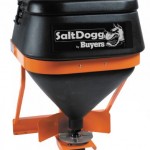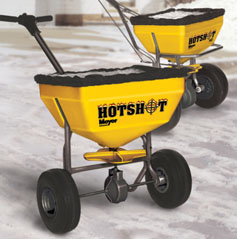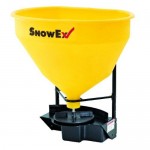 Broadcast salt spreaders fight ice and provide traction by throwing down a spread of salt, sand, ice melt mixture or a combination of the previously mentioned media. The Sand offers traction, and the salt helps the melting process along. The exact amount of media needed to cover an area is based on the thickness of the coating desired, the outside temperature and weather conditions, along with the accumulation of snow and ice already on the ground. Optimally, this application is laid onto an area where the bulk of the snow has been removed already.
Broadcast salt spreaders fight ice and provide traction by throwing down a spread of salt, sand, ice melt mixture or a combination of the previously mentioned media. The Sand offers traction, and the salt helps the melting process along. The exact amount of media needed to cover an area is based on the thickness of the coating desired, the outside temperature and weather conditions, along with the accumulation of snow and ice already on the ground. Optimally, this application is laid onto an area where the bulk of the snow has been removed already.
Spreaders are offered in a variety of configurations, including walk-behind, hand-held and truck or ATV mound spreaders. The larger the spreader, the more complex the machinery is a general rule. Almost every spreader system has a the same basic components:
- A hopper to hold the salt or sand media.
- A gate that allows the material to leave the hopper.
- A spinning disc or similar item to distribute the mix, as opposed to letting it fall straight down.
- Baffles to guide the material as is thrown from the spinner.
- A drive mechanism to turn the spinner.
Keeping the mix dry is essential. Dedicated salt spreaders offer a cover for the hopper, whereas the cheapie lawn spreader most likely does not. The materials used to make the hopper can make some difference here as well. When researching brands, notice that the higher end models have a liner inside the hopper or are made entirely from polyethylene. Better models my feature a screen at the bottom that prevents chunks from blocking the gate near the bottom of the hopper. An agitator or vibrator may be incorporated to keep the mix from lumping up as well.
 In most push-type spreaders, the motion of the wheels is the driving force for the spinner assembly. Handheld spreaders usually use a crank for the same purpose. Higher end and vehicle mount salt spreaders are most likely equipped with an electric motor that provides motion to the spinner.
In most push-type spreaders, the motion of the wheels is the driving force for the spinner assembly. Handheld spreaders usually use a crank for the same purpose. Higher end and vehicle mount salt spreaders are most likely equipped with an electric motor that provides motion to the spinner.
Hopper sizes vary. The perfect hopper size is a function of the spreading job itself. Ideally, you want to put enough material into the hopper to do the job but not so much that the weight makes it unwieldy. In the case of a truck mounted broadcast spreader, carrying enough salt mixture to do an entire run is obviously the way to go. Dry salt is usually lighter then sand.
The gate opening controls the amount of salt or sand mix that is allowed to leave the hopper, and having the ability to adjust the gate opening allows the operator to fine tune the density of the spread. The control can be adjusted based on the ice melting media being applied – for example, dry salt flows easier then sand. Large truck mounted spreaders have either a belt or auger to push the material from the hopper to the gate. Gravity is used on the smaller model for the same effect.
 Adjustable baffles allow the operator to direct the ice melting agent’s spread as it is thrown from the broadcast spreader. This can keep the radius from growing too large, prevent throwing into undesired areas and keep the mix from the operator’s feet. Fine tuning can change depending on the material or mix you are spreading, so adjusting the baffles can really dial in the spread you are trying to achieve.
Adjustable baffles allow the operator to direct the ice melting agent’s spread as it is thrown from the broadcast spreader. This can keep the radius from growing too large, prevent throwing into undesired areas and keep the mix from the operator’s feet. Fine tuning can change depending on the material or mix you are spreading, so adjusting the baffles can really dial in the spread you are trying to achieve.
Fighting stubborn ice becomes easier with a good spread of salt or chemical de-icing compound. Many applications use a mixture of sand and salt in one pass, providing the traction and ice melting benefits in a single pass. A good spreader will achieve a cost effective layer that coats the entire surface, something that is difficult when distributing the media by hand.
